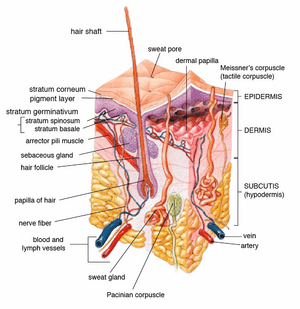Hyperhidrosis facts for kids
Hyperhidrosis is a health problem where a person sweats much more than usual. It often happens because the sweat glands in the body are too active. People with hyperhidrosis might sweat a lot even when they are cool and not doing anything active. While any part of the body can be affected, it most often happens on the palms of the hands, the soles of the feet, and in the armpits.
Contents
What is Hyperhidrosis?
Hyperhidrosis means "too much sweat." Sweating is a normal body function that helps keep us cool. But for someone with hyperhidrosis, their body sweats more than it needs to. This can happen without any clear reason, like being hot or exercising.
Why Do People Sweat So Much?
There are two main types of hyperhidrosis:
- Primary hyperhidrosis: This is the most common type. It usually starts in childhood or during the teen years. Doctors don't fully know why it happens, but it seems to run in families. This means if your parents or grandparents had it, you might too. It's not caused by other health problems or medicines.
- Secondary hyperhidrosis: This type is less common. It happens because of another health condition or a side effect from certain medicines. For example, some illnesses or hormone changes can cause people to sweat more. If the main health problem is treated, the sweating might get better.
Where Does It Happen?
Hyperhidrosis can affect different parts of the body. The most common areas are:
- Hands (palmar hyperhidrosis): Sweaty palms can make it hard to hold things or shake hands.
- Feet (plantar hyperhidrosis): Sweaty feet can lead to slippery shoes and foot odor.
- Armpits (axillary hyperhidrosis): This can cause noticeable wet spots on clothes.
- Face and head (craniofacial hyperhidrosis): Sweating on the face can be very visible.
Sometimes, people can have hyperhidrosis in more than one area at the same time.
How Do Doctors Help?
If someone sweats too much, a doctor can help figure out why and suggest ways to manage it. The goal is to reduce sweating and make life more comfortable.
Simple Ways to Manage Sweat
- Antiperspirants: These are often the first thing to try. Stronger, "clinical strength" antiperspirants can be bought without a prescription. They work by blocking the sweat ducts.
- Wearing the right clothes: Choosing loose-fitting clothes made of natural fabrics like cotton can help. These materials let your skin breathe.
- Good hygiene: Washing regularly and drying thoroughly can help prevent skin irritation and odor.
- Changing socks often: For sweaty feet, changing socks one or more times a day can help keep feet dry.
Medical Treatments
If simple methods don't work, doctors have other options:
- Prescription antiperspirants: These are stronger than what you can buy in stores. They contain more active ingredients.
- Iontophoresis: This treatment uses a mild electric current passed through water to the hands or feet. It helps to temporarily block the sweat glands. It needs to be done regularly.
- Medicines: Some medicines can help reduce sweating all over the body. These are usually taken by mouth.
- Botox injections: Small amounts of a special medicine can be injected into the armpits, hands, or feet. This medicine blocks the signals that tell sweat glands to produce sweat. The effects last for several months.
- Surgery: In very serious cases, a doctor might suggest surgery. This is usually a last resort. One type of surgery can cut the nerves that send signals to the sweat glands in the armpits or hands.
Living with Hyperhidrosis
Sweating too much can sometimes make people feel shy or worried. It might affect daily activities, like writing, using a computer, or playing sports. But it's important to remember that hyperhidrosis is a common condition, and there are many ways to manage it. Talking to a doctor or a trusted adult can help find the best solutions. Many people with hyperhidrosis live full and active lives by finding what works best for them.
See also
 In Spanish: Hiperhidrosis para niños
In Spanish: Hiperhidrosis para niños


